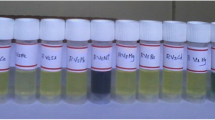Summary
The determination is based on the anion-induced In (III) wave, the sensitivity being dependent on the Alizarin S concentration. For eliminating the interference by cadmium and other elements, In is extracted into butyl acetate and re-extracted with hydrochloric acid. The latter is necessary in order to obtain a polarographically active form of the complex, taking advantage at the same time of the higher sensitivity of the wave in aqueous solution. The presence of gallium (which behaves similar to indium) requires further addition of Alizarin S after reextraction and fresh preparation of the calibration curve. Presence of aluminium requires additional In extraction as chlorocomplex. The standard deviation of the method is I p=0.237±0.009 μA (±4%) for 10−5 M In(III).
Zusammenfassung
Das beschriebene Verfahren zur pulspolarographischen Indiumbestimmung beruht auf einer anioninduzierten Adsorptionsstufe des In3+, wobei die Empfindlichkeit von der Alizarin S-Konzentration abhängig ist. Um Störungen durch Cadmium und andere Elemente zu vermeiden, wird In mit Butylacetat extrahiert und anschließend mit Salzsäure reextrahiert. Dies ist notwendig, um eine polarographisch aktive Form des Komplexes zu erhalten. Gleichzeitig wird dabei die größere Empfindlichkeit der Stufe in Wasser ausgenutzt. Bei Gegenwart von Gallium, das sich ähnlich wie Indium verhält, ist nach der Reextraktion weiterer Alizarin S-Zusatz notwendig und dadurch auch die Aufstellung einer neuen Eichkurve. Bei Gegenwart von Aluminium muß eine Extraktion des In als Chlorokomplex vorgeschaltet werden. Die Standardabweichung der Methode liegt bei I p=0,237 ±0,009 μA (±4%) für 10−5 M In3+.
Similar content being viewed by others
Literatur
Birjuk, E. A., Nazarenko, V. A.: Zh. Anal. Khim. 30, 1720 (1975)
Bulovova, M.: Collect. Czechoslov. Chem. Commun. 19, 1123 (1954)
Engel, J., Lawson, J., Aikens, D. A.: Anal. Chem. 37, 203 (1965)
Koch, O. G., Koch-Dedic, G. A.: Handbuch der Spurenanalyse, Berlin 1974
Otomo, M., Tonosaki, U.: Talanta 18, 438 (1971)
Sommer, H.-D., Umland, F.: Fresenius Z. Anal. Chem. 285, 359 (1977)
Sommer, H.-D., Umland, F.: Fresenius Z. Anal. Chem. 301, 203–206 (1980)
Vinogradova, E. N., Kamenev, A. J.: Zh. Anal. Khim. 24, 1661 (1969)
Author information
Authors and Affiliations
Additional information
I. Mitt.: [7]
Wir danken der Deutschen Forschungsgemeinschaft, Bonn-Bad Godesberg, dem Minister für Wissenschaft und Forschung des Landes Nordrhein-Westfalen, Düsseldorf, sowie dem Verband der Chemischen Industrie, Fonds der Chemie, Frankfurt/Main, für finanzielle Unterstützung.
Rights and permissions
About this article
Cite this article
Keim, K., Sommer, H.D. & Umland, F. Pulspolarographische Bestimmung von Metallionen unter Ausnutzung der Ligandenkatalyse. Z. Anal. Chem. 301, 207–209 (1980). https://doi.org/10.1007/BF00476185
Received:
Issue Date:
DOI: https://doi.org/10.1007/BF00476185



